
The Legend of Zelda is an action-adventure game franchise created by the Japanese game designers Shigeru Miyamoto and Takashi Tezuka. It is primarily developed and published by Nintendo, although some portable installments and re-releases have been outsourced to Flagship, Vanpool, and Grezzo. Its gameplay incorporates action-adventure and elements of action RPG games.

Balloon Fight is an action video game developed by Nintendo and HAL Laboratory and published by Nintendo. The original arcade version was released for the Nintendo VS. System internationally as Vs. Balloon Fight, while its Nintendo Entertainment System counterpart was released in Japan in 1985 and internationally in 1986.
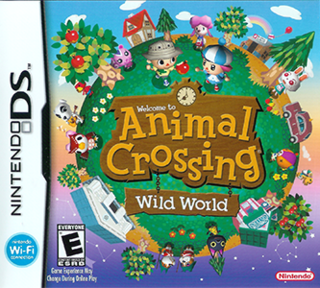
Animal Crossing: Wild World is a 2005 social simulation video game developed and published by Nintendo for the Nintendo DS handheld game console. It was released in Japan in November 2005, in North America and Australia in December 2005, and in Europe in March 2006. It is the second installment in the Animal Crossing series, and the sequel to Animal Crossing on the GameCube.

Pokémon Diamond Version and Pokémon Pearl Version are role-playing video games developed by Game Freak and published by The Pokémon Company and Nintendo for the Nintendo DS in 2006. They are the first installments in the fourth generation of the Pokémon video game series. They were first released in Japan on September 28, 2006, and released in North America, Australia, and Europe in 2007. Pokémon Platinum, a third version, was released two years later in each region. Remakes titled Pokémon Brilliant Diamond and Shining Pearl were released for the Nintendo Switch worldwide on November 19, 2021. A prequel, Pokémon Legends: Arceus, was released for the Nintendo Switch on January 28, 2022.

Nintendogs, styled as "nintendogs", is a real-time pet simulation video game developed and published by Nintendo for the Nintendo DS handheld video game console. It was released in Japan, and was later released in: North America, Australia, New Zealand, Europe and other regions. It was originally released in three different versions: Dachshund & Friends, Lab & Friends and Chihuahua & Friends. It has been re-released twice, first as a bundled release with a special edition Nintendo DS with a new version called Nintendogs: Best Friends and later as Nintendogs: Dalmatian & Friends.
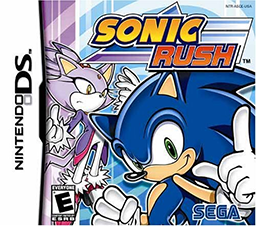
Sonic Rush is a 2005 platform game developed by Sonic Team and Dimps for the Nintendo DS as part of Sega's Sonic the Hedgehog series. It was released on November 15, 2005, in North America, November 18 in the PAL region, and November 23 in Japan, and was the final game in the mainline Sonic series to be produced by Yuji Naka before his departure from Sega. It is a 2D platform game, similar to earlier games in the series like Sonic Advance, as well as later ones like Sonic Mania. Levels in the game are side-scrolling and displayed using both of the DS's screens. However, boss battles, the main characters, and a special stage are rendered in 3D, creating a 2.5D effect. The game's storyline follows the intertwining adventures of the series' main character, Sonic the Hedgehog and a new character, Blaze the Cat. They respectively battle Doctor Eggman and his doppelgänger Eggman Nega at certain points.

Mario's Cement Factory is a 1983 LCD game developed and published by Nintendo under their Game & Watch series. It follows earlier Mario games, like the arcade and Game & Watch versions of Donkey Kong. Players control Mario as he navigates elevators and funnels cement through a factory, while trying to prevent the cement from crushing his fellow workers. Two versions of the game were released — a Table Top unit and a handheld game akin to most other Game & Watch titles. Development was headed by Nintendo R&D1, led by engineer Gunpei Yokoi.

Urban Champion (アーバンチャンピオン) is a fighting video game developed and published by Nintendo in 1984. It was first released for the Famicom and Nintendo VS. System for arcades in 1984, and later released for the Nintendo Entertainment System in North America and Europe in 1986. It was inspired by the 1984 Game & Watch game Boxing. It is Nintendo's first 2D fighting game, eventually followed in 1993 by Joy Mech Fight, released exclusively in Japan for the Famicom.
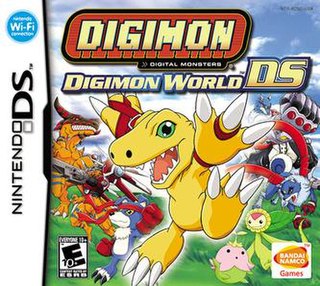
Digimon World DS, known in Japan as Digimon Story, is a role-playing video game for the Nintendo DS developed by BEC and published by Bandai Namco Games. The game was released in Japan on June 15, 2006, and in North America later that year on November 7. Despite its localized title, the game shares no relation to the separate Digimon World series.

Digimon World Dawn and Digimon World Dusk, originally released as Digimon Story Sunburst & Moonlight in Japan, are two role-playing video games for the Nintendo DS handheld game console released in Japan on March 29, 2007 and North America on September 18, 2007. Together, they serve as the second instalment of the Digimon Story series, part of the larger Digimon franchise. Despite their western title, the games are not part of the Digimon World series.
Rune Factory is a franchise of fantasy role-playing simulation games created by Yoshifumi Hashimoto and primarily published by Marvelous. The games are developed by Hashimoto's studio Hakama, taking over from Neverland after they ceased operations in 2013. The series began as a spin-off to Marvelous' flagship franchise Story of Seasons. The Story of Seasons references were subsequently dropped starting with the second installment, in order to become its own series. With the first game published in 2006, the property consists of five main-series games, two spin-off titles and numerous manga adaptations.

Mario & Sonic at the Olympic Games is a 2007 crossover sports and party game developed by the Sega Sports R&D Department. It is the first installment on the Mario & Sonic series. It was published by Nintendo in Japan and by Sega in other regions, and released on the Wii in November 2007 and the Nintendo DS handheld in January 2008. The first official video game of the 2008 Summer Olympic Games, it is licensed by the International Olympic Committee (IOC) through exclusive licensee International Sports Multimedia (ISM), and is the first official crossover game to feature characters from both the Mario and Sonic the Hedgehog series.

Race Driver: Create & Race is a racing video game developed by Firebrand Games and published by Codemasters exclusively for Nintendo DS. It is part of the TOCA / Race Driver series.

Pokémon Platinum Version is a 2008 role-playing video game developed by Game Freak and published by The Pokémon Company and Nintendo for the Nintendo DS handheld game console. It is the third version after Pokémon Diamond and Pearl and is part of the fourth generation of the Pokémon video game series. It was released in Japan on 13 September 2008, and later in North America, Australia, and Europe in 2009.

Guitar Hero: On Tour is a series of music video games based on the Guitar Hero series for the Nintendo DS handheld game system. The series is developed by Vicarious Visions and published by Activision. Three games in the series have been released since June 2008: Guitar Hero: On Tour, Guitar Hero On Tour: Decades, and Guitar Hero On Tour: Modern Hits.
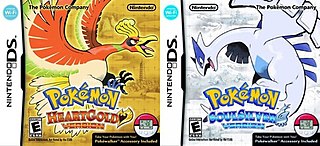
Pokémon HeartGold Version and Pokémon SoulSilver Version are 2009 remakes of the 1999 Game Boy Color role-playing video games Pokémon Gold and Silver, also including features from Pokémon Crystal. The games are part of the fourth generation of the Pokémon video game series, developed by Game Freak and published by The Pokémon Company and Nintendo for the Nintendo DS. In commemoration of the 10th anniversary of Gold and Silver, the games were released in Japan on September 12, 2009, and were later released in other regions during March 2010.
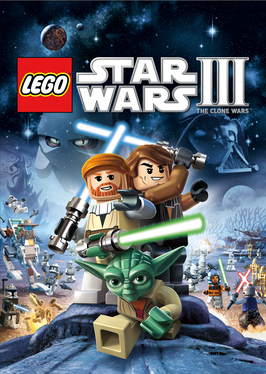
Lego Star Wars III: The Clone Wars is a Lego-themed action-adventure video game developed by Traveller's Tales and published by LucasArts in March 2011 for the PlayStation 3, PlayStation Portable, Xbox 360, Wii, Nintendo DS, Microsoft Windows, and the Nintendo 3DS. It was one of the 3DS's launch titles. The game features missions and characters from the 2008 animated film Star Wars: The Clone Wars and its follow-up television series, as well as fan-favorites from the original Star Wars saga, in both single-player and multiplayer gameplay modes. The Mac OS X version of the game was released by Feral Interactive.

Mega Man Zero Collection is a compilation of all four Mega Man Zero video games, which were originally released for the Game Boy Advance between 2002 and 2005. It was developed by Inti Creates and published by Capcom, and was made available worldwide in June 2010 for the Nintendo DS. The collection contains new features such as a beginner-friendly "Easy Scenario" that grants power-up items and abilities from the beginning of each game, as well as unlockable character art and the ability to display artwork on the Nintendo DS's bottom screen as the game is played. A similar compilation, Mega Man Zero/ZX Legacy Collection, was released in 2020.


















